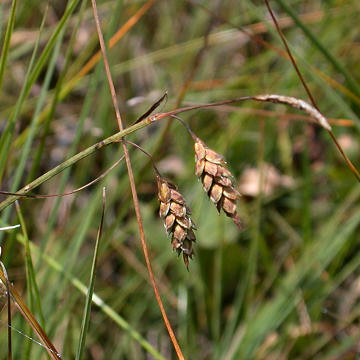

Carex limosa - (image 1 of 3)
Taxonomy
Family: Cyperaceae
Section Limosae
Habitat
Sphagnum bogs; floating organic mats over mineral-rich water.
Associates
Distribution
Circumboreal; in North America south to NJ, DE, OH, IA, and CA.
Morphology
Perennial to 60 cm from long, creeping rhizomes; stems single or few, lacking leaves at the base; roots covered with a yellowish-brown, felt-like tomentum; leaves few, to 2 mm wide, often with one or more longitudinal grooves or channels (canaliculate); terminal spike staminate, to 3 cm; pistillate spikes 1-3, nodding, on slender peduncles, 1-2.5 cm; the scales light to dark brown, about equaling the perigynia in length and width, obtuse to acute or acuminate; perigynia pale greenish or straw-colored, densely papillate, elliptic to ovate, somewhat flattened, two-ribbed with 4-7 nerves on each face, to 4.2 mm, beak absent or 0.2 mm or less; achenes trigonous.
Notes
Fruiting June to July
Wetland indicator: OBL
I photographed this plant at the edge of a fen in the Adirondacks that had been impacted by beaver activity. Thanks to Linda Curtis for making the identification. The specific epithet means "sitting in mud". Birds of the genus Limosa (Godwits) are large shorebirds that frequent mud flats.
Carex magellanica Lam. ssp. irrigua (Wahlenb.) Hultén is similar but has scales that are narrower than the perigynia.
References
Curtis, L. 2006. Woodland Carex of the upper Midwest. Lake Villa, IL.
Gleason, Henry A. and A. Cronquist. 1991. Manual of Vascular Plants of
Northeastern United States and Adjacent Canada. Second Ed.
The New York Botanical Garden. Bronx, NY
Swink, F. and G. Wilhelm. 1994. Plants of the Chicago Region.
Indiana Academy of Science. The Morton Arboretum. Lisle, Illinois.
|
© Michael Hough 2010 |